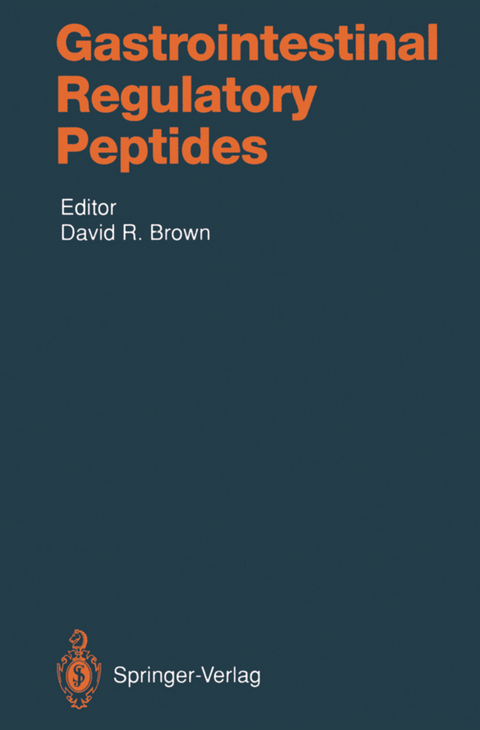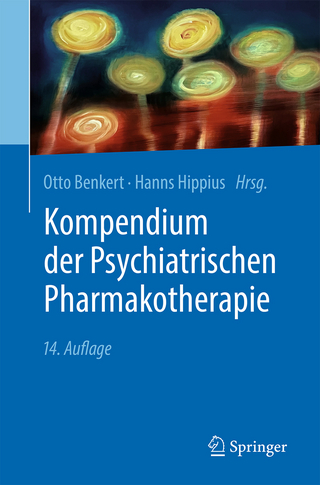
Gastrointestinal Regulatory Peptides
Springer Berlin (Verlag)
978-3-642-77816-2 (ISBN)
1 Localization and Colocalization of Gastrointestinal Peptides.- A. Introduction.- B. Coexistence of Messengers.- C. Endocrine and Paracrine Cells.- D. Enteric Neurons.- References.- 2 Regulation of Gastrointestinal Peptide Hormone Gene Expression.- A. Introduction.- B. Gene Structure.- C. RNA Polymerase II.- D. Transcriptional Regulation Overview.- E. Analysis of Gene Expression.- F. Regulation of Specific Hormone Gene Expression.- G. Conclusion.- References.- 3 Post-Translational Processing of Regulatory Peptides.- A. Introduction.- B. General Design of Processing Systems.- C. Intracellular Trafficking and Processing Pathways.- D. Processing Sites and General Mechanisms.- E. Enzymes Involved in the Processing of Prohormones.- F. Processing of Specific Prohormones.- G. Conclusion.- References.- 4 Regulation of Peptide Secretion from Gastroenteric Endocrine Cells.- A. Introduction.- B. Gastroenteric Endocrine Cells.- C. Neurotransmitter and Peptide Regulation of Release.- D. Nutrient Regulation of Peptide Release.- E. Regulation of Release by Luminal pH.- F. Summary.- References.- 5 Peptide Receptors and Signal Transduction in the Digestive Tract.- A. Introduction.- B. General Considerations and Methodology.- C. Signal Transduction by Receptors.- D. Peptide Receptors in the Digestive Tract.- E. Conclusion and Perspectives.- References.- 6 Proteolytic Inactivation of Neurohormonal Peptides in the Gastrointestinal Tract.- A. Introduction.- B. Proteolytic Enzymes Implicated in the Inactivation of Neurohormonal Peptides in the Gastrointestinal Tract.- C. Pathways of Proteolytic Inactivation of Some Gastrointestinal Hormones.- D. Pathways of Proteolytic Inactivation of Some Gastrointestinal Neuropeptides.- E. Conclusion.- References.- 7 Peptidergic Regulation of Gastric AcidSecretion.- A. Introduction.- B. Acid Secretory Control Mechanisms In Vivo.- C. Peptide Effects on Isolated Cells.- References.- 8 Peptides and Enteric Neural Activity.- A. Introduction.- B. Electrophysiology of Enteric Nerves.- C. Actions of Peptides on Enteric Nerves.- D. Conclusions.- References.- 9 Peptidergic Regulation of Smooth Muscle Contractility.- A. Introduction.- B. Regulation of Smooth Muscle by Peptide Hormones.- C. Regulation of Smooth Muscle by Neural Peptides.- References.- 10 Peptidergic Regulation of Intestinal Electrolyte Transport.- A. Introduction.- B. Transport Models for Absorption and Secretion.- C. Regulation of Intestinal Transport by Peptide Neurohormones.- D. Concluding Remarks.- References.- 11 Peptidergic Regulation of Gastrointestinal Blood Flow.- A. Introduction.- B. Gastrointestinal Peptides.- C. Capsaicin-Sensitive Afferent Nerves.- References.- 12 Peptidergic Regulation of Cell Proliferation Through Multiple Signaling Pathways.- A. Introduction.- B. Growth-Promoting Activities of Neuropeptides in Cultured Cells.- C. Early Signaling Events.- D. Evidence for Growth-Promoting Effects of Neuropeptides In Vivo.- E. Conclusions.- References.- 13 Peptidergic Regulation of Mucosal Immune Function.- A. Introduction.- B. Overview of Immune Function in Gut-Associated Lymphoid Tissue.- C. Peptide Effects on Immune Function.- D. Conclusion.- References.- 14 Pathophysiological Aspects of Gut Peptide Hormones.- A. Introduction.- B. Esophagus.- C. Stomach.- D. Duodenum.- E. Pancreas.- F. Gallstones.- G. Small Bowel.- H. Colon.- J. Gastrointestinal Hormones and Cardiovascular Function.- K. Conclusions.- References.- 15 Gastrointestinal Peptides as Therapeutic Agents and Targets: Past, Present and Future.- A. Introduction.- B. Diagnostic Use of Gastrointestinal Peptides.- C. Peptides as Agonists in Therapeutics.- D. Antagonists of Peptides in Therapy.- E. The Future.- References.
| Erscheint lt. Verlag | 16.12.2011 |
|---|---|
| Reihe/Serie | Handbook of Experimental Pharmacology |
| Co-Autor | A. Alemayehu, B. Amiranoff, D.L. Barber, S.R. Bloom, J. Calam, R.E. Carraway, Feng Chen, C.S. Chew, C.C. Chou, J.M. Conlon, A. Couvineau, E. Ekblad, T.S. Gaginella, J.J. Galligan, J.R. Grider, R. Hakanson, P. Kitabgi, M. Laburthe, Y.P. Loh, M.S. O'Dorisio, S.M. O'Grady, R.K. Pearson, R.J. Playford, E. Rozengurt, F. Sundler, I. Zachary |
| Zusatzinfo | XX, 446 p. |
| Verlagsort | Berlin |
| Sprache | englisch |
| Maße | 155 x 235 mm |
| Gewicht | 708 g |
| Themenwelt | Medizin / Pharmazie ► Medizinische Fachgebiete ► Pharmakologie / Pharmakotherapie |
| Medizin / Pharmazie ► Pharmazie | |
| Schlagworte | Biology • Cells • hepatology • hormones • receptor • Research • smooth muscle • synthesis |
| ISBN-10 | 3-642-77816-X / 364277816X |
| ISBN-13 | 978-3-642-77816-2 / 9783642778162 |
| Zustand | Neuware |
| Haben Sie eine Frage zum Produkt? |
aus dem Bereich


